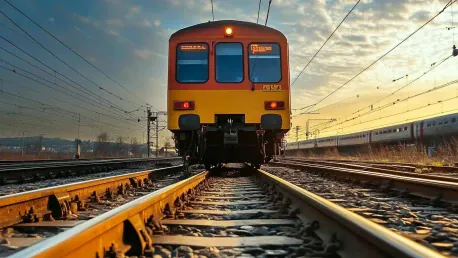Oliver Sinclair sat down with Rohit Laila, an esteemed expert in the logistics industry known for his deep understanding of railway safety and his passion for technological innovation. We engaged in a thoughtful conversation about the newly launched “Stay off the Tracks” campaign by Network Rail and the British Transport Police. This campaign aims to raise awareness about the dangers of railway tracks and the severe consequences trespassing can have. Our discussion revolved around various aspects including public awareness, safety misconceptions, and the intense, gripping content of the campaign.
Can you tell us more about the new “Stay off the Tracks” campaign?
The “Stay off the Tracks” campaign is a fresh initiative designed to drive home the real and present dangers of trespassing on railway tracks. Using powerful visuals and testimonies from first responders, it vividly portrays the traumatic consequences of coming into contact with the third rail, which carries a deadly 750 volts of electricity. The goal is to make people fully aware of the risks they are taking when they step onto the tracks.
What are the main goals of this campaign?
Our primary objectives with this campaign are to educate the public about the hidden dangers of railway tracks, correct common misconceptions, and ultimately reduce the number of trespassing incidents. We want to highlight that the risks are not just about being hit by a train, but also about the very real danger of severe electrical injuries. It’s about creating a lasting impression that prevents people from making potentially fatal decisions.
How does this campaign build on previous efforts like the “You vs Train” campaign?
The “Stay off the Tracks” campaign builds on the foundational work of the “You vs Train” campaign by adding raw, personal stories from those who have witnessed the aftermath of track-related accidents. This approach aims to deepen the emotional impact and present a more comprehensive picture of the severe consequences. By featuring first responders, we bring a human element that highlights not only the physical injuries but also the emotional toll on victims and their families.
The survey data shows a lack of public awareness about the dangers of railway tracks. Why do you think this is?
There are several factors at play here. Railways have grown ubiquitous, and familiarity often breeds a false sense of security. Many people underestimate the speed and quietness of modern trains. Additionally, there’s a significant lack of education regarding the dangers of the third rail and other hidden hazards on the tracks. This knowledge gap is something we’re working diligently to close.
What are some of the most surprising statistics revealed by the survey?
The survey results were indeed eye-opening. Learning that 59% of people don’t even know what the third rail is was striking. Even more concerning was the revelation that 38% of people didn’t believe electrocution from railway tracks could cause serious injury. Perhaps most alarming was the statistic that 41% think it’s safe to walk on tracks when no trains are coming. These misconceptions underline the urgent need for increased public education.
How does the campaign aim to address these misconceptions?
We’ve crafted the campaign to be as informative and impactful as possible. By using vivid visuals, real-life stories, and expert testimonies, we aim to dispel myths and replace them with facts. The emphasis on first responders’ experiences is meant to make the dangers more relatable and real. Our goal is for these stories to stick in people’s minds and deter risky behavior around railway tracks.
What exactly is the ‘third rail,’ and why is it so dangerous?
The third rail is an electrified rail that provides power to the trains. It carries a high voltage of around 750 volts, which is more than enough to cause severe electrical burns, cardiac arrest, and immediate death upon contact. The danger lies in its high voltage and the fact that it’s always charged, posing a constant risk to anyone who comes into accidental or intentional contact with it.
Can you explain the typical injuries that occur from coming into contact with the electric rail?
Injuries from the electric rail are typically severe and life-threatening. They often include deep burns, which can damage skin, muscles, bones, and even internal organs. Victims might suffer from neurological damage or traumatic amputations as a result of the high voltage. The recovery process is long and painful, often requiring multiple surgeries and extensive rehabilitation.
What are some common misconceptions people have about electrocution on the railway?
Many people mistakenly believe that simply avoiding direct contact with the third rail or overhead lines means they are safe. They often underestimate the possibility of accidental contact, slipping, or the capability of the electricity to arc and jump short distances. There’s also a dangerous myth that only touching the rail while grounded will cause harm, which is completely false—any contact can be fatal.
The campaign features first responders talking about their experiences. Why was it important to include their perspectives?
Including first responders offers an authentic and compelling perspective. These are the people who see the consequences of railway trespassing first-hand. Their stories bring a human element to the campaign, making the dangers more tangible and relatable. Hearing directly from those who deal with these incidents can be powerful in breaking through public apathy and fostering a sense of urgency and responsibility.
How do these incidents impact not only the victims but also their families and friends?
The toll is profound and far-reaching. Victims often face lifelong physical and psychological challenges. Their families and friends suffer emotional trauma, financial burdens from medical expenses, and the heartbreak of seeing a loved one endure severe suffering. These impacts ripple out to affect entire communities, which is why it’s so vital to prevent these incidents from happening in the first place.
Can you share any specific stories or examples mentioned in the campaign that highlight these impacts?
In the campaign, there’s a particularly harrowing story shared by a first responder about a young person who survived but faced severe and disfiguring burns after contacting the third rail. The emotional toll on the victim’s family, who had to adapt to new caregiving roles and cope with the trauma, was palpable. These real-life accounts are crucial in showing the true cost of such preventable accidents.
The campaign content is quite graphic and viewer discretion is advised. Can you explain why this level of intensity was necessary?
This level of seriousness is necessary because we are dealing with life-and-death situations. The graphic content is meant to shock and educate simultaneously. People often underestimate the risks of railway tracks, and a more visceral approach can make the dangers feel more immediate and real. It’s about leaving a lasting impression that can prevent future tragedies.
How have you ensured the content is respectful while still conveying the seriousness of the message?
We’ve been very mindful of balancing respect with impact. Our goal is not to sensationalize, but to educate. We worked closely with industry professionals to recreate incidents accurately and respectfully. The focus remains on the stories of real impacts and the voices of first responders. By grounding the content in reality and genuine concern for public safety, we aim to deliver strong messages respectfully.
Why do so many people believe it’s safe to walk on the tracks when no trains are coming?
This misconception likely arises from a lack of awareness about the speed and frequency of modern trains. Many people also underestimate how quietly they can approach. There’s a false sense of control that if no train is visible, it’s safe to cross—this is a dangerous myth. The truth is that trains can come at any time and from either direction, often without any audible warning until it’s too late.
What are the risks associated with picking up items from the tracks?
The risks are significant. You risk electrocution from the third rail or being struck by an oncoming train. Tracks are not designed for pedestrian traffic, and the uneven, slippery surfaces increase the likelihood of tripping or falling, which can turn a momentary lapse in judgment into a fatal accident. It’s always safer to notify railway authorities if something needs to be retrieved.
What advice would you give to people who consider taking shortcuts across the tracks?
Never take shortcuts across the tracks. It might save a few minutes, but the risks are simply not worth it. Always use designated crossings and overpasses. The minor inconvenience of walking a bit farther or waiting for a crossing signal pales in comparison to the potential consequences of a fatal accident or severe injury. Stay safe and always respect railway boundaries.
How do trespassing incidents affect train schedules and overall railway operations?
Trespassing incidents have a massive impact on railway operations. Trains have to be stopped, causing delays and cancellations. This ripple effect disrupts thousands of passengers, leading to missed connections and appointments. There’s also the considerable economic cost associated with these delays and the need for repairs and increased security measures, which ultimately burden taxpayers.
What are the economic costs associated with these incidents?
Economically, trespassing incidents amount to millions of pounds annually. There’s the direct cost of stopping and restarting trains, track repairs, and the deployment of emergency services. These disruptions also lead to lost productivity as passengers are delayed. Railway operators must invest in additional safety and monitoring measures to prevent future incidents, all of which adds up.
What measures are being taken to minimize these disruptions?
We are implementing a mix of preventive measures. This includes increased surveillance with cameras, physical barriers to deter access to the tracks, more frequent patrolling by railway and law enforcement, and extensive public awareness campaigns like “Stay off the Tracks.” We’re also leveraging technology to better detect and respond to trespass activities in real-time.
What role do Network Rail and the British Transport Police play in managing these incidents?
Network Rail and the British Transport Police work collaboratively to manage these incidents. Network Rail focuses on infrastructure, safety measures, and monitoring the network, while the BTP handles law enforcement and public safety. They investigate incidents, apprehend trespassers, and work proactively to prevent unauthorized access. Both organizations are dedicated to reducing incidents and enhancing rail safety.
How can the public help in reducing trespass incidents?
Public awareness is key. Individuals can help by educating themselves and others about the dangers of railway tracks. Reporting any suspicious activity or trespassing incidents to authorities immediately can also prevent accidents. Engaging with safety campaigns and disseminating this information through community networks can collectively create a safer environment for everyone.
What steps should someone take if they witness trespassing?
If you witness someone trespassing, the best action is to contact the British Transport Police by texting 61016 or calling 999 in an emergency. Do not attempt to confront the trespassers yourself, as it can be dangerous. Providing clear information to the authorities can help them respond quickly and effectively, potentially saving lives and preventing further incidents.
Do you have any advice for our readers?
My advice is simple yet crucial: always prioritize your safety and the safety of others. Understand that railway tracks are inherently dangerous places and respecting boundaries can save lives. Educate yourself, your family, and your community about the risks and encourage responsible behavior around trains and tracks. One moment of care can prevent a lifetime of regret.









